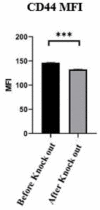A Decrease in CD44 on Cell Surfaces (MKN-45 cell line) After RELA Knockout Using CRISPR/Cas9
- PMID: 37091035
- PMCID: PMC10116351
- DOI: 10.22088/IJMCM.BUMS.11.2.117
A Decrease in CD44 on Cell Surfaces (MKN-45 cell line) After RELA Knockout Using CRISPR/Cas9
Abstract
The NF-kB signaling pathway was introduced as a key pathway in carcinogenesis that is induced by inflammation in gastrointestinal malignancies. The RelA transcription factor is an important component of this signaling pathway. Furthermore, CD44 is implicated in the tumorigenesis and metastasis of gastric cancer. The aim of this study was to assay the effect of RELA knockout on CD44 expression in MKN45 cells. CRISPR/Cas9 was used to knock out RELA in MKN-45. The median fluorescence intensity (MFI) of CD44 before and after RELA knockout is analyzed in MKN45. The CRISPR/Cas9 vector pSpCas9 (BB)-2A-Puro (PX459) was used for gRNA cloning (two guides). The MKN-45 cell line was co-transfected. The purified co-transfected cells with puromycin were cultured and used for the RELA gene expression assay by real-time PCR. Flow cytometry was used for the analysis of the MFI of CD44+ in MKN45. The results showed that 180 nucleotide sequences between exon 2 and exon 3 of RELA were deleted in MKN45. RELA expression significantly (P<0.001) decreased after CRISPR/Cas9 knockout. Compared to the control group, the MFI of CD44 in transfected cells significantly decreased (P <0.001). Knockout of RELA significantly decreased CD44 expression in MKN45 cells. It can be concluded that the NF-kB signaling pathway via RELA is related to CD44 expression and consequently the tumorigenesis of gastric cancer. More studies about this relationship are recommended.
Keywords: CD44; CRISPR/Cas9; MKN-45 cell line; RELA; knockout.
Figures




Similar articles
-
A study on the functions of ubiquitin metabolic system related gene FBG2 in gastric cancer cell line.J Exp Clin Cancer Res. 2009 Jun 10;28(1):78. doi: 10.1186/1756-9966-28-78. J Exp Clin Cancer Res. 2009. PMID: 19515249 Free PMC article.
-
CRISPR/Cas9-mediated double knockout of SRPK1 and SRPK2 in a nasopharyngeal carcinoma cell line.Cancer Rep (Hoboken). 2020 Apr;3(2):e1224. doi: 10.1002/cnr2.1224. Epub 2019 Nov 27. Cancer Rep (Hoboken). 2020. PMID: 32671994 Free PMC article.
-
Frequency of CD44 positive cells in MKN45 cell line after treatment with docetaxel in two and three-dimensional cell cultures.Tissue Cell. 2020 Apr;63:101324. doi: 10.1016/j.tice.2019.101324. Epub 2019 Dec 16. Tissue Cell. 2020. PMID: 32223952
-
Altered Expression of CD44, SIRT1, CXCR4, miR-21, miR-34a, and miR-451 Genes in MKN-45 Cell Line After Docetaxel Treatment.J Gastrointest Cancer. 2020 Jun;51(2):520-526. doi: 10.1007/s12029-019-00274-1. J Gastrointest Cancer. 2020. PMID: 31273630
-
Plasmid-based CRISPR-Cas9 system efficacy for introducing targeted mutations in CD81 gene of MDA-MB-231 cell line.Folia Histochem Cytobiol. 2022;60(1):13-23. doi: 10.5603/FHC.a2022.0007. Epub 2022 Feb 14. Folia Histochem Cytobiol. 2022. PMID: 35157300
References
-
- Wang F, Meng W, Wang B, et al. Helicobacter pylori-induced gastric inflammation and gastric cancer. Cancer Lett. 2014;345:196–202. - PubMed
-
- Ghasemi S, Mozdarani H, Soleimani M. The Effect of miR-372 on genome instability in MKN-45 cell line. J sfahan Med Sch. 2014;32:2035–47.
LinkOut - more resources
Full Text Sources
Miscellaneous
